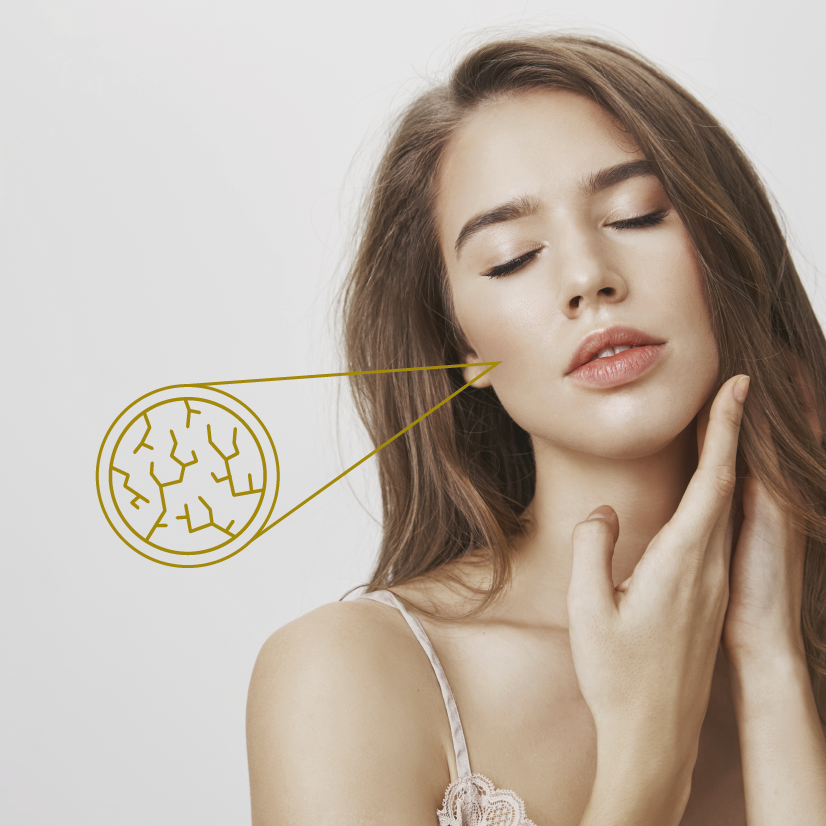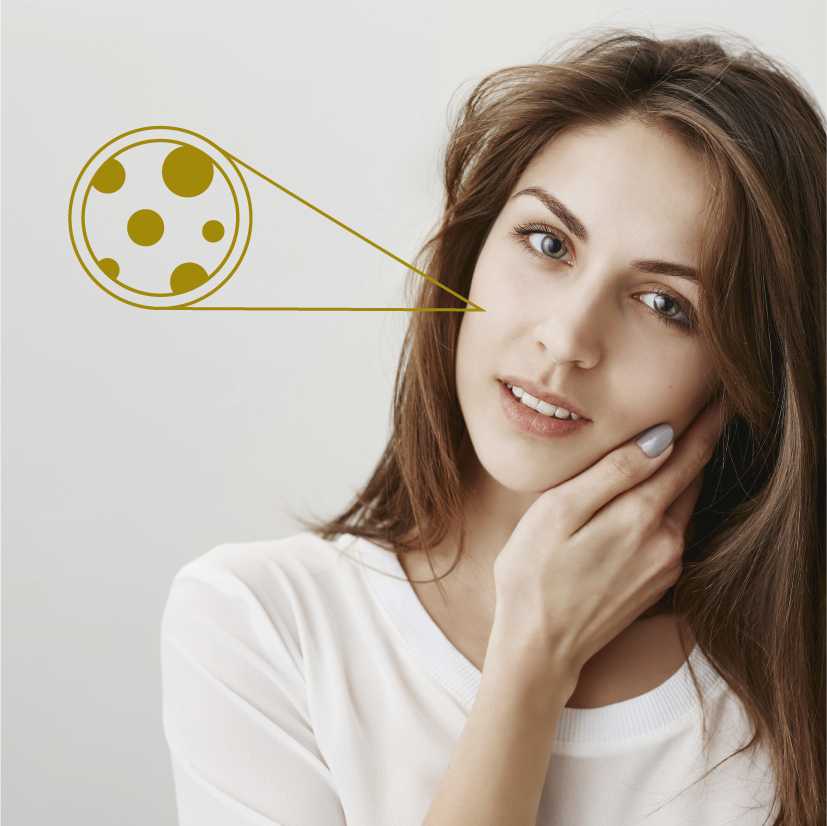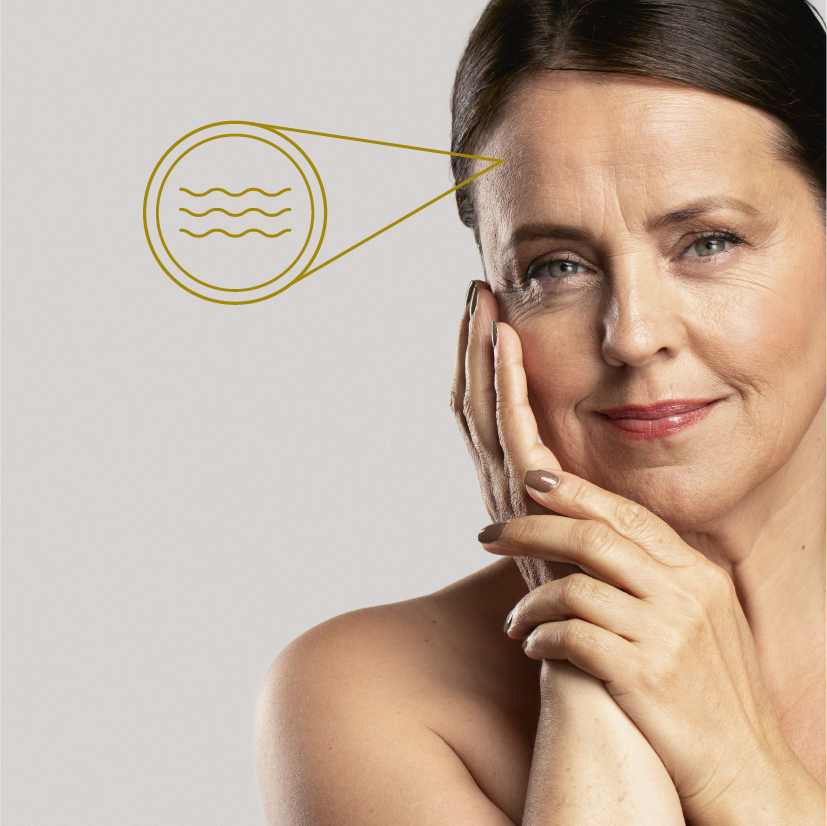Your skin type is uniqe and genetically determined. The starting point for determining your skin type is sebum production. Your skin naturally secretes sebum to keep the skin supple and greasy, but some skin produces more sebum than others. Little sebum means dry skin; too much sebum means oily skin. Although congenital generally means that it does not change throughout your life, skin type can change temporarily or gradually under certain influences.
Dry Skin

Dry skin and dehydrated skin are often confused with each other. Although they do often occur together, dry skin is not the same as dehydrated skin.
Dehydrated (or dehydrated) skin is a skin condition where there is a lack of moisture in the skin. Dry skin, on the other hand, lacks skin fats (sebum) and is a skin type.
In dry skin, the skin barrier is damaged due to a lack of skin fats. This allows moisture to escape from the skin and dries it out. The shortage of skin fats, also called lipids, can have several causes. Dry skin can be innate but can also be caused by the use of soap or products containing alcohol. Dry skin needs fats and oils that fill and imitate the skin barrier, so to speak. This allows the skin to recover and feel less dry. Ingredients that help with dry skin include shea butter and oils such as jojoba, avocado or sunflower oil.
Characteristics of dry skin
- Dry skin is often thinner in texture. Flakes may be visible.
- Dry skin has fine, barely visible pores and the skin produces little sebum.
- Dry skin can also occur on, for example, arms and legs.
Recommended products
Oily Skin

Unlike dry skin, oily skin produces too much skin fat (sebum). Oily skin can have several causes. It can be innate, but also hormonal changes such as fluctuations during puberty, use of contraception or pregnancy can contribute to oily skin. Oily skin often shows impurities. Due to increased sebum production, the skin is unable to process the abundance of sebum. The pores are dilated and become clogged more quickly, causing pimples or blackheads to form. But on the other hand, wrinkles are also less likely to occur with oily skin!
Incorrect skin care can cause the skin to produce more sebum than necessary. Aggressive cleansing products containing soap and alcohol remove all sebum but also stimulate sebum production, making the skin even oilier. It is therefore very important to care for the skin properly, with the right products. Oily skin needs balance. Choose mild products that do not dry out the skin.
And although oily skin has an increased production of sebum, this skin can still be dehydrated! Therefore, oily skin can also benefit from moisturizing products.
Characteristics oily skin
- The skin has a thicker, firmer structure.
- The skin begins to glow during the day and feels oily.
- The pores are clearly visible.
- The skin may contain impurities such as blackheads, pimples and/or inflammation.
Recommended products
Combined Skin

More than 80% of people have combination skin! Combination skin is, as the name suggests, a combination of different skin types. Certain areas of the skin, often on the T-zone (forehead, nose and chin) show oily properties. The pores are clearly visible here and this area can become shiny during the day.
But with combination skin, the cheeks, on the other hand, are often normal or even dry.
The challenge with combination skin is to find the right care that takes into account both the oily and dry areas of the skin. During the day, combination skin benefits from matifying products that reduce shine in the T-zone. At night, choose a moisturizing cream.
Characteristics of combination skin
- The skin begins to glow during the day. Especially on the nose, chin and forehead, the so-called T-zone.
- The pores are particularly visible in the T-zone and impurities may occur.
- The cheeks are often normal to dry and may even show flaking.
Recommended products
Normal Skin

"Normal" in this case means that the skin is well balanced in terms of sebum production. The pores are not or hardly visible, the skin is supple and the face has an even, fresh complexion with a healthy glow. Although normal skin is balanced in terms of sebum production, the condition of this skin type can be dehydrated, sensitive or aging. In addition, normal skin can become oilier due to improper care. As we age and the epidermis becomes thinner, normal skin may begin to show drier characteristics.
It is important to maintain the balanced sebum production of normal skin with the right products. Also take the skin condition into account here. For example, pay extra attention to specific characteristics such as redness or skin aging.
Characteristics of normal skin
- The skin has small pores and hardly any impurities.
- The skin is supple and has a velvety, soft glow.
- The skin has a fresh, pink complexion and uniform transparency.
Recommended products
Skin Conditions
The skin also has a certain condition: the skin condition. The skin condition is influenced by internal and external factors and can therefore be variable. Internal factors that can change the skin condition are hormonal fluctuations (pregnancy, puberty, menopause, disease). Age also changes the skin condition, think of sagging skin, drier skin, dull appearance. External factors that change the skin condition are improper cosmetic use (aggressive ingredients that clog pores or damage the skin barrier) and seasonal changes (changes in temperature and humidity). In most cases, the skin condition can be improved or remedied with the right skin care products.
Sensitive Skin

There is no general yardstick that determines when a skin is sensitive. Therefore, the client's experience is often leading in determining sensitive skin.
A sensitive skin wil quickly react to external factors such as heat, cold, wind or UV radiation or products containing alcohol, soap or perfume. In addition, there are a number of factors that increase the likelihood of sensitive skin. For example, women are generally more likely to suffer from sensitive skin than men. Sensitivity can also vary by season. Weather conditions, heating and air conditioning can make the skin more sensitive. Finally, lifestyle can also affect the condition of the skin, making it more sensitive. For example, stress, illness and medication.
In 80% of cases, sensitive skin is caused by improper skin care. A disturbed barrier function of the skin makes the skin less resistant to irritating factors. With the right care, this can be restored. In addition, sensitive skin benefits from good protection to reduce reactions to external influences.
Characteristics of sensitive skin
- The skin is often thin and fine-textured.
- The skin reacts quickly to external influences (sun, wind and cold), but also to soap, perfume and alcohol.
- Reactions often manifest themselves as irritation, redness, itching, burning, stinging, scaly patches or dry skin.
Recommended products
Dehydrated Skin

When the cells in the skin layers contain less than 10% moisture we call the skin dehydrated. A lack of moisture can have various causes. Most obvious is a general lack of water in the body, for example by not drinking enough. But a lack of moisture can also be caused by a shortage of lipids and other substances that make the skin less able to retain moisture. Finally, a compromised skin barrier can also lead to dehydrated skin. This is often caused by aggressive cleaning products, frequent showering or excessive exfoliation.
Just adding water to the skin is not enough. Products with moisture-binding properties, which ensure that moisture is better retained in the skin, are the best choice for dehydrated skin. It is also important to restore the barrier function of the skin. Ingredients that benefit dehydrated skin include hyaluronic acid, vitamin C, panthenol and glycerin.
Characteristics of dehydrated skin
- In dehydrated skin, wrinkles and dry lines quickly appear. These disappear again as soon as the moisture level is restored.
- If you look closely at the skin you can see craquelé-like ridges in the skin.
- A dehydrated skin feels easily tight and uncomfortable.
Recommended products
Sallow or Tired Skin

Tired skin occurs when the skin has symptoms of deficiencies. Causes of these deficiencies can be related to stress and unhealthy living conditions such as smoking, lack of sleep or dehydration due to air conditioning or not drinking enough, for example.
Fatigue is often the first thing to show around the eyes; puffiness, dark circles and swelling. A lack of sleep is the most obvious cause of this. During your sleep, the lymphatic system drains fluid and waste products. If you don't sleep enough, this system can't do its job properly and fluid and waste products can accumulate under your eyes. Drinking too little water or too much caffeine or alcohol can also lead to puffiness.
Smoking also causes sallow, tired skin. Nicotine constricts the blood vessels in the skin, which means less oxygen and nutrients can be transported. This results in a drab, sallow skin tone. In addition, nicotine can also give the skin a yellowish glow.
Depending on the cause of the deficiencies, we can look at what treatment and products best suit this skin condition.
Characteristics of sallow or tired skin
- The skin looks somewhat dull, gray or sallow and shows little color.
- The skin has a low-energy, lifeless appearance.
- Puffiness and/or dark circles are visible around the eyes.
Recommended products
Mature and Sagging Skin

Skin aging is a process that begins around the age of 25. It means that the metabolic process in all cells slows down. As a result, skin cells are not produced as quickly and the skin becomes thinner, but damage to the skin also heals less quickly. Where the skin normally renews itself every 30 days, this process takes longer as we age.
In addition, the essential connective tissue cells that provide the flexibility and firmness of the skin are produced less and less. They are responsible for the production of elastin and collagen. Elastin and collagen give the skin its firmness and elasticity. Until the age of 25, the production of collagen is in balance with its degradation. However, the production of collagen in the skin decreases by about 1% per year as we age. As a result, the skin loses its elasticity and firmness and wrinkles develop.
Although skin aging is a natural process that we cannot stop, there are a number of factors that can accelerate the aging process. The biggest culprit in this is overexposure to UV rays. But also stress, smoking, caffeine, alcohol, sugar, dieting, sleep deprivation, medication use, improper cosmetic use and chronic irritation of the skin.
Characteristics of sagging skin
- The skin exhibits fine lines and wrinkles and loses noticeable firmness and elasticity.
- The jawline and neck are less tight.
- Due to a reduced ability to bind moisture, the skin is dehydrated.
